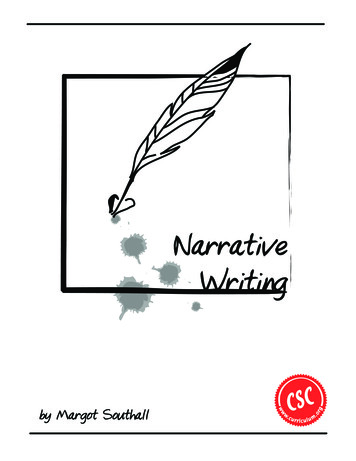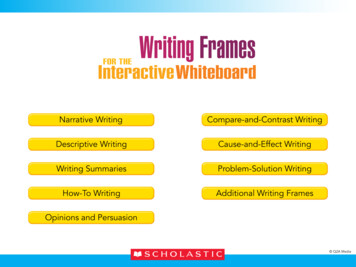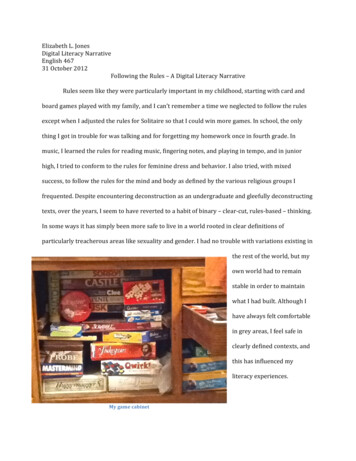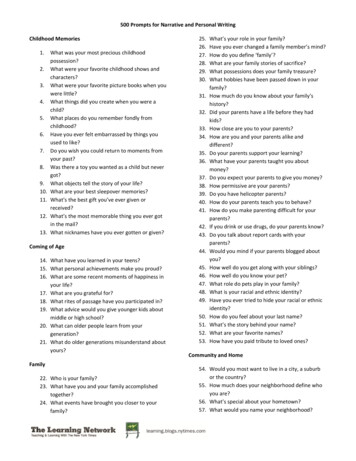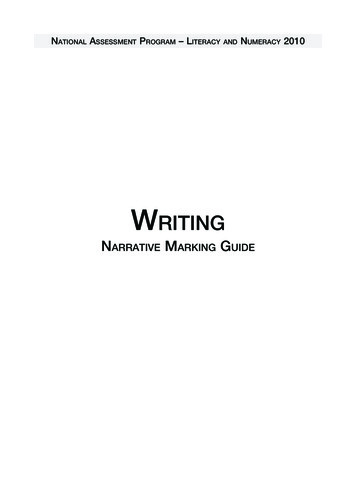
Transcription
W.3.3Narrative Writing: A Fictional Story (FN1)Prewriting: Writing a Fictional Story: Mentor TextWriting Teaching Point(s): Students will read mentor text and complete graphic organizer on Writer’s Notes. Students will write a summary of the story in their own words.Standard(s):W.3.3 Write narratives to develop real or imagined experiences or events using effectivetechnique, descriptive details, and clear event sequences.a. Establish a situation and introduce a narrator and/or characters; organize an event sequence thatunfolds naturally.b. Use dialogue and descriptions of actions, thoughts, and feelings to develop experiences and events orshow the response of characters to situations.Materials: Chart paper and markers Text for Prudy’s Problem by Carey Armstrong Ellis (handout) Chart: Definition of Imagined Fiction and Organizational Structure STORY Graphic OrganizerConnection:“So far this year, you have studied and completed two writing units. You began with the personal narrative and wrote about a true event that really happened to you. You have also had the opportunity to write informational pieces where you chose an ‘expert’ topic.Using important facts, you wrote to inform your reader.Today we begin a new unit of study—writing a fictional short story. Unlike a personal narrative or informationalarticle, a fictional story is ‘made up’ or not true.In this unit you will write a story using your imagination to create characters and invent scenes to entertain yourreader.”Teach (modeling):The teacher shares how well-written stories have engaged her/him as a reader with i.e., well developedcharacters, an intriguing setting, a satisfying ending, etc.“Today we are going to read our model text. Prudy’s Problem, by Carey Armstrong Ellis, will give us a text torefer to as we write our own stories about made-up characters and situations. While this book was written toentertain us, we are going to read for a different purpose. We are going to turn on our detective eyes and lookfor the writer’s craft. We will examine the elements of a story: the setting, the talking characters, the problem,how the characters attempt to solve the problem and the resolution.”Teacher creates STORY Anchor Chart:STORYSettingTalking CharactersOops! A problem!Attempts to ResolveYay! A solutionLink to Independent Practice“Now you are going to finish reading the story on your own. You may complete the chart as you read, the waywe have done, or after you finish reading the story. Remember, you are reading as a writer today, so notice allof the good writing strategies that Carey Armstrong Ellis uses as she tells us about Prudy.”Teacher circulates the room to assist students as needed in completing the organizer. May select students to fillin the classroom STORY organizer as appropriate.1
Active Engagement (guided practice):“I will begin reading the story aloud. As I am reading, if you hear something that we need to add to ourSTORY organizer, you should quietly raise your hand and be prepared to tell me where we should add it.”Begin reading. Pause as needed to complete chart. Stop reading at “Yeah, that would solve your problem!”agreed Harold and Belinda.“There is no problem!” shouted Prudy.“Let’s stop here to review the parts of our STORY organizer we have completed together.”Closure:“While I collect your STORY organizers, turn and talk with your partner about aspects of the story that youliked as a writer. Refer back to the text and identify some writing strategies that you might like to try in yourown writing.”Before the next class, teacher should review STORY organizers. Misinformation should be clarified either as awhole group at the beginning of class (if needed) or in small groups that focus on the structure aspect of thestory.Notes:Resources and References (adapted from, acknowledgements)Portland Public SchoolsA Fictional StoryA fictional story is ‘made up’ or not true. The author usesimagination to create characters and invent scenes to entertainthe reader. The character often faces a problem or conflict thatmust be resolved. The author engages the reader as the characterattempts to resolve the conflict.2
Prudy’s Problem and How she Solved ItBy Carey Armstrong-EllisPrudy seemed like a normal little girl. Shehad a sister. She had a dog. She had twowhite mice. She had a mom and a dad and herown room at home.Yes, Prudy seemed normal.“You just have too much stuff. Why don’twe haul it all to the dump?” he suggestedhopefully.“I don’t have too much stuff, Dad,” Prudysaid.But Prudy collected things.Now most kids collect something. Prudy’sfriend Egbert collected butterflies. So didPrudy. Belinda had a stamp collection. Sodid Prudy. Harold collected tin foil and madeit into a big ball. So did Prudy. All herfriends had collections. And do did Prudy—but Prudy collected everything.It even got to be too much for her mom, whodid not mind clutter but could no longernavigate the living room.“Maybe you could take all this to the thriftshop,” she said. “Surely someone could usethis old mushroom ”“I like that mushroom,” Prudy said.She saved rocks, feathers, leaves, twigs, deadbugs and old flowers. She kept a box full ofinteresting fungi in the bottom drawer of herdresser. She saved every picture she had everdrawn, and ever valentine she had evergotten. She saved pretty paper napkins in herdesk drawer. She had six hundred andfourteen stuffed animals in differentunnatural colors.She had collections of ribbons, shoelaces,souvenir postcards, flowered fabric scraps,pencils with fancy ends, pink scarves withorange polka dots, old calendars, salt andpepper shakers with faces, dried-out erasers,plastic lizards, pointy sunglasses, chinaanimals, heart-shaped candy boxes with thepaper candy cups still inside, tufts of hairfrom different breeds of dogs She just could not throw anything away.It drove her dad to distraction. He was a verytidy person who did not like clutter. Hestarted saying unpleasant things as he tried tomow the lawn. “Prudy, you have a problem,”he said.“What do you mean?” she asked, baffled.“Prudy, you have to face your problem,” saidher mother.“I do not have a problem,” said Prudy.Prudy’s little sister started putting togethercollections of her own.“Uh-oh,” said Egbert, eyeing Evie’s littlepiles of pine twigs and used toothbrushes.“Prudy, how about if you packed everythingall up and stuffed it into a rocket and sent it toNeptune?”“Yeah, that would solve your problem!”agreed Harold and Belinda.“There is no problem!” shouted Prudy.But Prudy herself found that she could barelyget to her desk to feed her mice.She could not even get out of her roomwithout setting off an avalanche of one thingto another.And then one day while Prudy was walkinghome from school, something shiny caught3
her eye. It was a silver gum wrapper.She visited a rock collection.“I must take this home for my shiny thingscollection!” she thought.She went to the library to find ideas.She ran home and tried to squeeze into herroom.Something started to happen. The wallsstarted to bulge. The door started to strain atthe hinges. The pressure was buildinghigher and higher The room exploded with an enormousBANG!Bits and pieces of stuff flew everywhere.At last, after many hours of scrutinizingstacks of books, she came up with a brilliantplan!With saws whirring and hammers pounding,everyone set to work.The Prudy Museum of IndescribableWonderment was an amazing sight to behold.Everyone wanted to go visit.Within a year, it was the biggest touristattraction in Prudy’s town.“Holy smokes,” said Prudy.“I guess maybe I do have a little problem.”“Look at that, Egbert,” said Belinda. “Didyou ever realize how many kinds of gymsocks there are?”For six weeks, everyone pitched in to gatherPrudy’s scattered collections.“Now what, Prudy?” said her family.“I had no idea cheese rinds could be sofascinating!” said Prudy’s mother.“Now what, Prudy?” said her friends.“Can I go to the gift shop?” said Evie.“I’m working on it!” said Prudy.Prudy looked around for inspiration. Shevisited an art collection.At last Prudy’s collections were neat andorderly and appreciated by everyone. Nowshe could sit back and enjoy the museum andall her happy visitors She visited a fish collectionBut she could never really stop collecting!4
Setting:STORYTalking Characters:Oops! Problem:Attempts to Resolve:Yes! Problem Solved:5
Narrative Writing: A Fictional Story (FN2) (2 days)Prewriting: Favorite Stories---What’s the Problem?Writing Teaching Point(s): Students will review the definition of a fictional story and create a short list of favorite titles. Students will analyze the structure of a fictional story.3Standard(s):W.3.3 Write narratives to develop real or imagined experiences or events using effectivetechnique, descriptive details, and clear event sequences.a. Establish a situation and introduce a narrator and/or characters; organize an event sequence that unfoldsnaturally.b. Use dialogue and descriptions of actions, thoughts, and feelings to develop experiences and events or show theresponse of characters to situations.Materials: Chart paper and markers Text for Prudy’s Problem (handout). Anchor Chart: ‘Our Favorite Stories—What’s the Problem? Chart: Definition of Imagined Fiction and Organizational Structure (Day 1)Connection:“So far this year, you have studied and completed a variety of writing. You began with the personal narrative and wrote about a true event that really happened to you. The next unit of study was the informational article. During this unit, you chose an ‘expert’ topic. Usingimportant facts, you wrote an article to inform your reader.Today we begin a new unit of study—writing a fictional short story. Unlike a personal narrative or informational article, afictional story is ‘made up’ or not true.In this unit you will write a story using your imagination to create characters andinvent scenes to entertain your reader.”Teach (modeling):The teacher shares how well-written stories have engaged her/him as a reader with i.e., well developed characters, anintriguing setting, a satisfying ending, etc.“All of us have enjoyed reading and listening to imagined stories. Maybe it was a story read aloud in class or at thelibrary. Perhaps it was mom or dad who shared this special story? Yesterday we read Prudy’s Problem, so let’s use thatstory and a few others we have read this year to complete our graphic organizer.”Teacher creates anchor chart: ‘Our Favorite Fictional Stories,’ i.e.Anchor Chart example: Students enter 3-5 titles of favorite stories:Favorite Fictional StoriesCharacterTitlePrudy’s Problem(student suggestions)ProblemSolution“I love reading, so it’s hard to name just one story! Yesterday we read our mentor text for this unit ‘Prudy’s Problem andHow She Solved It’. I love this story because the character is a lot like me -- I like to save things too! Another story I haveenjoyed this year is . The details about the setting of this story helped me see that there are amazing sightsaround the world!”6
Active Engagement (guided practice):Students consider their experiences reading and listening to fictional narratives. They share what made the readingespecially interesting or engaging.“Can you name a favorite imagined story that you’ve enjoyed?Take the next few minutes to remember the stories you have read. Think about books that have been read aloud.Which imagined or fictional stories have you especially enjoyed? Why?”Turn and Talk:“Let’s come back together in a partner share. Share with your partner the title of at least one story you particularlyenjoyed and tell why.”Large Group Share:“Now let’s add a few of your favorite examples to our anchor chart. We’ll record the title and tell about a specificfeature that was enjoyable or interesting.” It is important for the teacher to include several titles that are very familiarto most students, i.e., Charlotte’s Web, Diary of a Wimpy Kid, A Day’s Work, etc.7
Teach (modeling) (Second Day, if needed)Favorite Fictional Stories Chart---Add Problem-Solution:Using this chart, the teacher teaches the problem-solution element of an imagined story. “As you can see, there are manydifferent kinds of stories. But here’s an amazing fact-- all fictional stories share one essential feature: every story has aproblem that must be solved by the character.Let me show you what I mean. Fictional stories can be summarized in three easy steps: Character- Problem- Solution.Here are two examples: In the story, ‘Prudy’s Problem’, Prudy likes to collect things, but her room is so crowded it finally bursts. Soshe creates a museum to store her amazing things. (Teacher creates another example using a story from the anchor chart and modeling: “The characterlikes/wants, but, so” framework)Active Engagement (guided practice):Teacher and students describe the problem-solution elements in each of the sample stories.“Together, let’s name the Character-Problem-Solution for each of your favorite stories listed on the anchor chart.We’ll use the this sentence frame each time:Main character likes (or wants) , but . And so, .”8
Sample chart:Our Favorite Fictional Stories---What’s the Problem?TitleCharacterProblemPrudy’s ProblemPrudyLikes to collect,but her room isso crowded itbursts.(Student suggested)Likes/wants, butSolutionAnd so shecreates amuseum to storeheramazingAnd so things.Link to Independent Practice:“I know that you will enjoy creating your own imagined story.Remember, a story is basically a problem that must be solved. So, just as we’ve created a Character-Problem-Solution’chart for these stories, it will be helpful for you to use this structure for your own imagined story. ”Closure:“With a partner choose a fictional story that we’ve read in our anthology. Together, practice summarizing thestory by using the sentence frame:Main character likes (or wants) , but . And so, .Notes:Resources and References (adapted from, acknowledgements)Portland Public SchoolsA Fictional StoryA fictional story is ‘made up’ or not true. The author usesimagination to create characters and invent scenes to entertainthe reader. The character often faces a problem or conflict thatmust be resolved. The author engages the reader as the characterattempts to resolve the conflict or get what he or she wants.9
CharacterWantedButAnd so10
Narrative Writing: A Fictional Story (FN3)Prewriting: Character Development: Who are you?Writing Teaching Point(s): Students will use a graphic organizer to create a character for a story.Standard(s):W.3.3 Write narratives to develop real or imagined experiences or events using effectivetechnique, descriptive details, and clear event sequences.a. Establish a situation and introduce a narrator and/or characters; organize an event sequence thatunfolds naturally.Materials: Character Brainstorm chart, teacher and student copies Writing notebooksConnection:“We know that good stories need interesting characters. Since characters are so important in a story, manywriters often get started by imagining or creating a character. Today you will begin brainstorming ideas forthe main character of a story.”Teach (modeling):Using the sample chart, the teacher models making a list of the characters s/he knows well. This listingdemonstrates that familiar, everyday people can become the fictional characters of our stories.“It can be tricky to come up with good ideas for characters, but certain strategies can help whenbrainstorming. Published writers often give this tip, ‘start with what you know well.’So, instead of beginning the brainstorming with imaginary characters like mermaids, aliens and dragons, whynot begin with a list of people (or animals) we might ordinarily meet?Let me show you what I mean. I am going to think about the characters I might meet in a day, and list them on thisgrid. The top row of my grid is where I will list real people I see often. For example, I often walk to theneighborhood bakery for a muffin in the morning. So, I think I’ll begin my list of Character Ideas with baker/pastry chefAnd to my list I’ll add characters I see at school. . . boy/girl student At homeI might visit with elderly neighborNext, I’ll add the animals around my house. . . my old kitty11
opossum (I saw him cross my yard the other day!)“Now it is your turn. Think of some people you see often who you might want to create a story about.”Students take a few minutes to add ideas to the top row of their chart.“Now I want to think of some totally fantastical characters. I want to make up imaginary characters thatmight be magical or pretend. I’ll write these ideas in the second row of my chart.At my house socks are always getting lost in the laundry. I think there must be a sock-elf . . . living in my laundry room. my dog has dog parties when I am at school“Now you try. Use your imagination. Come up with some fantastical imaginary characters and write them downin the second row of your chart.”Students list imaginary character ideas.“In the third row I am going to think about real people I know, but twist them into something not real. Forexample, the woman who makes coffee at the coffee shop I like always wears cool scarves and earrings madefrom feathers. I am going to pretend she turns into a bird at night.”Add ideas to row three.“You will try this in a moment. Think of real people, then twist them into something not real. Write those ideasin row three. If you finish all three rows or you have an idea that doesn’t belong in those rows, use the fourthrow for even more ideas.”Active Engagement (guided practice):“Now it’s your turn. I want you to use the next few quiet minutes to remember or ‘see’ the characters(including animals) you might meet on an ordinary day.Pick a typical day. All the people you see can become a character.Where do you go? Who do you encounter or come across? What is this character doing?Finally, do you have an idea for one imaginary character (i.e. elf or dragon) to add to your character ideas?”Partner Share:Turn and share your character ideas with a partner.”12
Link to Independent Practice:“Now I want you to take all those great ideas for characters and just write or list them on your CharacterIdeas Chart. You can finish the boxes that are empty or add details to some of your characters. We will shareideas in a few minutes.”At the end of this short brainstorming session, students pair-share their grid and then the class does a zip aroundwith each student sharing a character and one detail.Teacher Example: i.e., An elf who lives in the laundry room.Teach (modeling):Short Write: Teacher models generating a short and simple character profile using a sentence prompt:Sample:is awho. . . . .“I can see that you have some great character ideas. So, as a Short Write assignment today, you willcontinue to visualize and describe your characters. First, draw a star next to 3 of your favorite characters. Now, compose a Short Write sentence that describes each of these 3 characters.Use this sentence format:is awho. . . . .I’ll share my thinking. Here’s an example. I’ll give the character a name, tell who he/she is, and share onedetail: Mr. Bloom is a dad who pampers a pet puppy he always carries in his coat pocket. Ms. Gray is an elderly neighbor who loves backyard gardening. Juliet is an elf who lives in the laundry room and loves to sing and dance.”Link to Independent Practice:Allow the students a minute or two for ‘think-time’. A modification may be to repeat this ‘think-time’ foreach of the three favorite characters.Now it’s your turn. Reread your list and star three favorite character ideas.I’m going to turn off the lights as you imagine each of your 3 characters. Close your eyes. For each character,think about a name. Introduce the character by telling who she/he is. What is unique about this character? Createone unusual detail.”Closure:“Fiction writers do a great deal of work imagining their characters before starting a story. Tomorrow you willspend more time getting to know a character.”Notes:Resources and References (adapted from, acknowledgements)Portland Public Schools13
Character IdeasReal peopleTotally made- upcharactersReal people with atwistOther ideasis awhois awhois awho14
Narrative Writing: A Fictional Story (FN4) (2 days)Prewriting: Character Development: Let Me Introduce Myself!Writing Teaching Point(s): Students will use a graphic organizer to create a character for a story.3Standard(s):W.3.3 Write narratives to develop real or imagined experiences or events using effectivetechnique, descriptive details, and clear event sequences.a. Establish a situation and introduce a narrator and/or characters; organize an event sequence thatunfolds naturally.b. Use dialogue and descriptions of actions, thoughts, and feelings to develop experiences and events orshow the response of characters to situations.Materials: Completed Character Brainstorm grid, teacher and student copies, Lesson 3 Mentor text, Prudy’s Problem by Carey Armstrong Ellis T-Chart: What do we learn about Prudy? T-Chart: teacher sample Interview worksheet, ‘In My Character’s Shoes’, teacher and student copiesConnection:“Last session you began the important work of imagining characters. Today you will choose one character andspend more time getting to know that character.”Teach (modeling):“Let’s begin by studying how another author, Carey Armstrong Ellis, develops her character in the story, Prudy’sProblem. Today, I want you to think about what the author does to introduce us to the character.”Project the story’s text or have students turn to their handout. Read aloud the beginning of the story with studentsfollowing along. After the read aloud, teacher and students discuss the main character and record information on TChart.What do we learn about Prudy? The Author tells the reader. . .Active Engagement (guided practice):Think-Pair-Share“Now with your partner, review the middle part of this story. Ms. Ellis gives us several details that help us knowPrudy as a real person. Note particularly what Prudy says and how she acts.”After a few minutes have the students volunteer ideas. Together, students and teacher, continue to listcharacter details on the projected T chart.“What further do we learn about the main character?” What do we learnabout Prudy? Author tells the reader. . . Character says. . . Character acts. . . Other characters say. . .15
Teach (modeling):“Like this author, I want to develop an interesting character for my story.So today, I will use the interview statements on ‘In My Character’s Shoes’ to help me ‘become’ the character, and I willbrainstorm believable details. When you put yourself in someone else’s shoes, you pretend you are them and think aboutwhat life is like for them.”Think aloud to demonstrate for students how to create details using the graphic organizer. Explain your thinking andanswer for each ‘interview question.’ See teacher sample, i.e.‘Juliet is a talented and creative elf who lives in a downstairs laundry room. Juliet loves acting and pretending. She’salways dancing and twirling on the piles of fresh laundry. She ‘performs’ for her parents--- tap dancing and singing on theironing board (stage).’“Now that I’ve imagined all these things about Juliet, I am ready to think of a story to tell about her.”Link to Independent Practice:“Now it is your turn to brainstorm some important details about your character.Work to create a character that is in some ways similar to kids or people you know well. That way, even though yourcharacter is imaginary, he/she will seem real to the reader.”Allow students enough time to brainstorm and illustrate their character.Closure:Share in partners or small groups.Notes:Resources and References (adapted from, acknowledgements)Lesson adapted from Writing Like Writers by Kathryn Johnson and Pamela Westkott, pages 129-130.Portland Public Schools16
What do we learn about the character called Prudy?The author tells us. . .The character says. . .The character acts. . .Other characters say. . .17
In My Character’s Shoes---An InterviewMy name is, Juliet but I like to be calledyears old and I live with my mother and father.I amin9abright and cozy laundry room in a house owned by a livelylady named Ms. Maggie. Ms. Maggie loves to sing and dance tothemusic on her radio and ipod.This is what I look like:18
Shhhh! I have a secret. I like to bounce and pounce on the pilesof fresh laundry. And I like to sing and dance too. Sometimes I‘steal’ pieces of lace and silk to make costumes. I also likeMs. Maggie’s pretty socks.My most fun thing to do is pretend I’m a STAR. I love to sing inthe sink (it echoes!) and tap dance on the ironing board.I’m really good at pretending. I can also create great costumes.I never like to sit quietly.It’s so hard to be a ‘proper’elf.My most special thing in the whole world is a fancy piece of furand feather from Ms. Maggie’s slipper. I have a bad habit of‘stealing’ shiny, soft, feathery things from the laundry room.One more thing you should know about me is I want to be a STAR!19
In My Character’s Shoes---An InterviewMy name is, but I like tobe called.old and I live withinI amyears.This is what I look like:20
Shhhh! I have a secret. I.My most fun thing to do is.I’m really good at.I never like.My most special thing in the whole world is. I have a bad habit of.One more thing you should know about me is21
Narrative Writing: An Imagined Story (FN5)Prewriting: It’s a Struggle—Creating a Conflict and SolutionWriting Teaching Point(s): Students will develop a problem and solution for the character they have created.3Standard(s):W.3.3 Write narratives to develop real or imagined experiences or events using effectivetechnique, descriptive details, and clear event sequences.a. Establish a situation and introduce a narrator and/or characters; organize an event sequence that unfoldsnaturally.Materials: Anchor Chart, Lesson 1: ‘Our Favorite Stories----What’s the Problem?’ Completed interview worksheet, ‘In My Character’s Shoes’, teacher and student copies. Graphic organizer, ‘Create a Conflict’, sample using mentor text, teacher sample and student copies.Connection:“In our previous lessons you have worked hard to create an interesting main character. Today you will createthe story for your character by crafting a problem and solution.”Teach (modeling):“You know that a really good story grabs the reader’s attention with a problem. That is, the main character struggles withsome kind of trouble or conflict.”(Review Anchor Chart, ‘Our Favorite Stories- What’s the Problem?’ As a review, briefly discuss the different kinds ofproblems the characters face in these stories.)“How do writers figure out what the conflict in their story will be? Once the writer has spent some time getting to knowhis character well, he asks himself some important questions.”Project the graphic organizer, ‘Create a Conflict’.Here is a list questions authors may consider: What is special about this character? How might this (unusual behavior) become a problem? What are some kinds of problems the character may face? What is the main event that happens right before the character solves the problem? And so, how is the problem solved?Active Engagement (guided practice):Teacher and students use the mentor text and the organizer questions to uncover how the author develops a problemand solution to create a story.Let’s return to our mentor text, Prudy’s Problem and try to answer these questions together.”See sample chart. The author creates a character--- a ‘normal little girl with a sister, mom and dad and a dog.’Except, Prudy collects things---too many things.22
Teach (modeling):“If these are some questions that writers ask when creating a story, I want to try answering the samequestions for my character. So, I am going to review my character sketch and interview questions. Thisinformation will help me figure out some ideas for a problem.”“While I reread my interview worksheet, ‘In My Character’s Shoes’, you reread yours.”Allow adequate time for your students.Project the organizer and model writing ideas in each section. (See Teacher Model example)“I have tried to think of some problems that make sense for my character. I’ll share my thinking. . . Juliet makessuch a racket singing and dancing, she might be ‘caught’ by Ms. Maggie! Juliet’s mother is very worried, and shewarns, ‘Juliet, you must be quiet and still.’ This is a real struggle for Juliet: her toes want to dance and her lipswant to sing. Then (the big event) one spring day she hears Ms. Maggie singing as she does her spring cleaning.Juliet tries very hard to be still, but finally she bursts into song and Ms. Maggie spies her!So . . . the two dance and sing together all day long!”Hmm. Here’s another idea for a problem. Juliet likes to create costumes. She sees all the pretty lace andcolorful fabric on the clothes in the laundry pile. She spies the fancy fur and feathers on Ms. Maggie’s slipper.Juliet is tempted to take just a little piece of fabric or fur. She thinks, “It’s so small (and it’s so old) Ms.Maggie won’t even miss it! Juliet agonizes. Should she or shouldn’t she take just a tiny piece of fabric?Finally, Juliet decides to write Ms. Maggie a note asking for a donation.So. . . Ms. Maggie screams when she reads the note. This is evidence that an elf is living in her laundry room.But then she thinks about how much fun she has singing and dancing. She wants Juliet to have fun too. Shecreates a special, tiny, donation basket just for Juliet!”Active Engagement (guided practice):“Now, you get to brainstorm a problem and solution for your character. Take a few minutes to read thequestions and think about your ideas.”Think-Pair-Share: “Share some ideas with your partner.”Students Work Independently:“Now, let’s get to work. Fill in the spaces of your ‘Create A Conflict’ organiz
6 Narrative Writing: A Fictional Story (FN2) (2 days) Prewriting: Favorite Stories---What’s the Problem? Writing Teaching Point(s): Students will review the definition of a fictional story and create a short list of favorite titles. Students will analyze the structure of a fictional story. Standard(s): 3 W.3.3 Write narratives to

